The ASUS Zenbook UX305 Review
by Brett Howse on March 25, 2015 8:00 AM ESTBattery Life
Not everyone requires battery life in a laptop. For some, a laptop is something you move from desk to desk, and can keep power close at hand. However even for those types of people (like me) there are going to be times where battery life is much more important, such as on a long trip. We have seen the bar raised considerably in the last several years with respect to battery life.
The ASUS UX305 has the power sipping Core M processor, whose 4.5W TDP means that the CPU/SoC's power consumption is kept quite low. But that is of course only part of the story. The display is a huge driver in energy use, and as we have seen in recent reviews, high resolution displays, although beautiful to look at, can use much more energy than those that sport a lower resolution. Unlike our Dell XPS review, we do not have both the low and high resolution models available for comparison, so for now we will focus on the 1080p model that is available.
To test battery life, we have two workloads. Our light test is light web browsing, and our heavy test increases the number of pages loaded, adds a 1 MB/s file download, and has a movie playing. We set all displays to 200 nits.
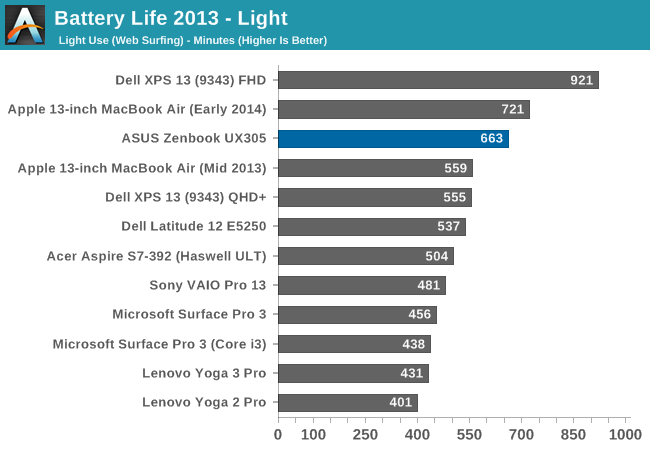
ASUS has packed tremendous battery life into this tiny fanless laptop. At just over 11 hours, it is one of the best results we have seen from any device, and it is all done on just a 45 Wh battery. It is not quite as efficient as the Dell XPS 13, despite the Dell having a 15 watt CPU, but the CPU is just a small part of this test, as it is generally not under much load. To see how the device fares under a heavier load, we will take a look at our Heavy test next.
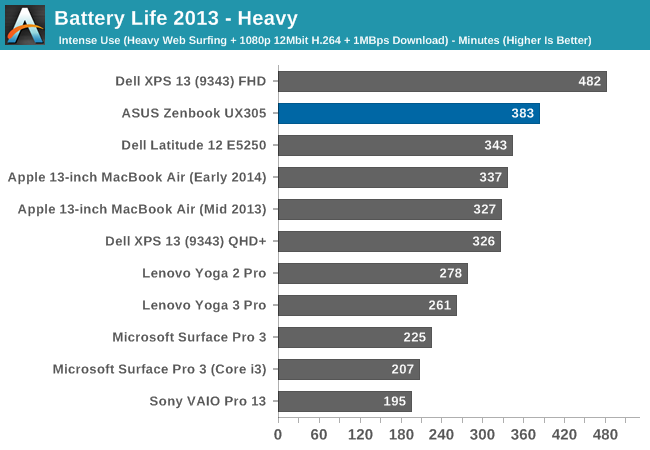
Once again the ASUS performs very well. Despite the thin design, the UX305 has plenty of battery life to handle most workloads with ease. Once more it doesn't quite measure up to the XPS 13, but that device also has a larger battery. To compare all of our devices for energy efficiency with the battery size removed from the equation, we have our normalized graphs.
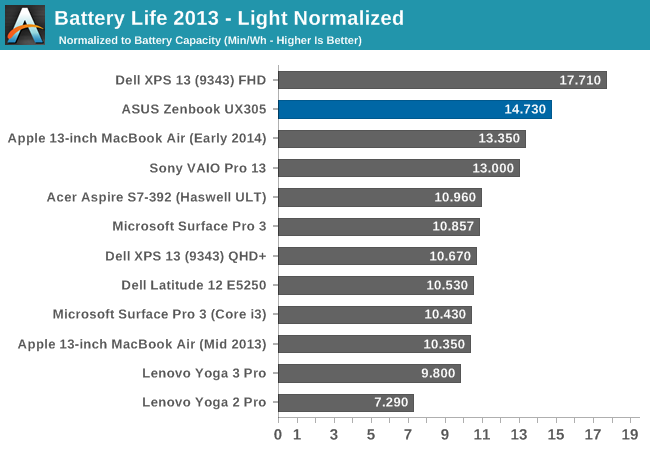
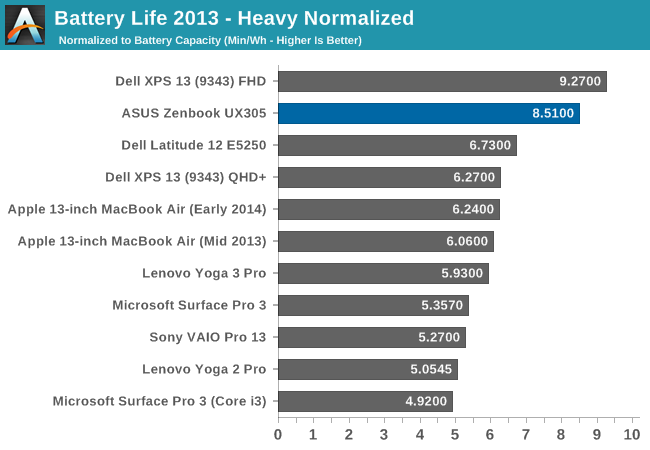
ASUS has done a great job on the overall platform efficiency of the UX305. While not quite class leading, it is quite a bit higher than most devices on the market. With just a 45 Wh battery, the UX305 does an outstanding job.
Charge Time
The other factor in mobility is charge time. Long battery life is great, but if you can top up quickly it can really extend the range of a notebook. The UX305 comes with a 45 watt charger, which seems to be fairly typical these days. There is certainly a trade-off to be made between charging speed and portability, because no one wants to bring a 3 lb charger along with a 2.6 lb notebook.
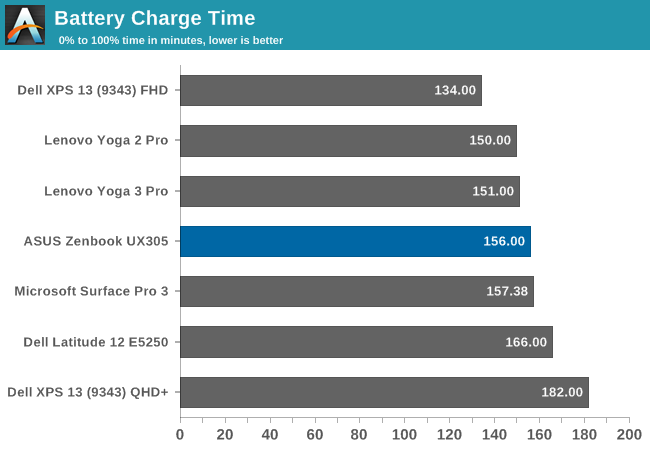
At 156 minutes, the UX305 falls right in line with most devices. Although there is little stopping someone from providing a faster charging rate, it seems most OEMs have settled on at or around this score as a target.
The UX305 charges very consistently, with it only leveling out well after 80% charge.
ASUS would be able to improve these scores with a higher wattage charger, but as compared to its peers it is about the same.
Wi-Fi Performance
ASUS has outfitted the UX305 that we have in for review with the Intel Dual Band Wireless-N 7265 wireless networking chip (not to be confused with the Wireless-AC 7265), which also includes Bluetooth 4.0 support. The change from the 7260 adapter seen predominately last year is a drop in power consumption. With a 2x2:2 design, the 7265 can connect at a maximum of 300 Mbps on 5 GHz. ASUS will be offering an 802.11ac card in the higher priced version of the UX305 which comes with the 3200x1800 display.
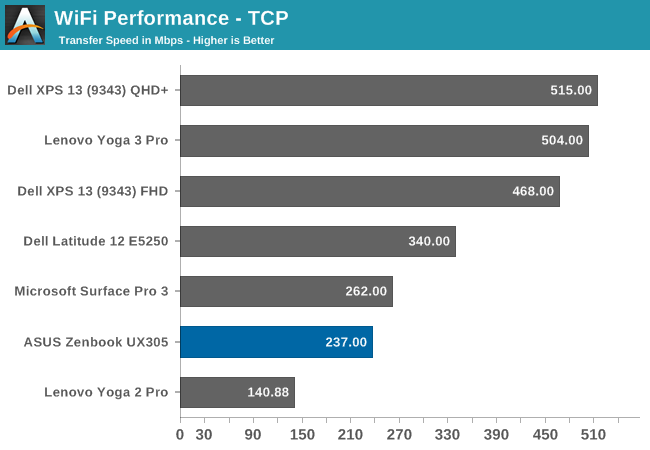
With just 300 Mbps maximum connection speed, the UX305 is sorely outclassed by devices which offer 802.11ac. ASUS is good enough to include a USB 3.0 Ethernet adapter though, for those that require more speed. Using the adapter, I was able to achieve 902 Mpbs transfer rates on our Wi-Fi benchmark. Frankly, I do appreciate the offer, but the money spent on the adapter could have just been used to give the UX305 802.11ac across the board, rather than just on the higher priced model. It is trivial for people to purchase a USB 3.0 Ethernet adapter if they need it, and plug it in, but replacing the Wireless card inside one of today’s laptops is a lot more challenging. This, like the display which raises the laptop, is one decision I have to question about the UX305.
Speakers
In their press materials ASUS has made a big deal about the engineering effort put into the speakers in the UX305, which were developed by the Golden Ear team at ASUS. As stated earlier, the UX305 sports two downward firing speakers, housed in 1.7 cubic centimeter chambers. The speaker dimensions are 25 x 9 x 3 mm and include a “high-intensity” coil. They also include some equalizer software to assist the user in setting the equalizer for various modes, such as VoIP calls, or music.
The audio solution is provided by Conexant and is a 2075x variant, so it should have around 2.8 watts of output power split between the two channels.
All of this being said, playing music I was only able to achieve around 76 dB (A weighted) which is about typical for this type of thin and light device. The outlier here is the Dell XPS 13 which manages 86 dB on the same music track. 10 dB means that the Dell is twice as loud.
However maximum volume is only one side of the equation. We will take a look at the frequency response of the speaker design next.
As you can see from the graph, there is little in the way of low end response, which I suppose is not unexpected for such small speakers. There is really not much in the way of audio response at all until after 200 Hz. There is also a big dip right at 1500 Hz. Overall, these are not the greatest speakers, but they should be fine for watching a few videos. Headphones would be needed for anything where you want to hear the full audio range though.


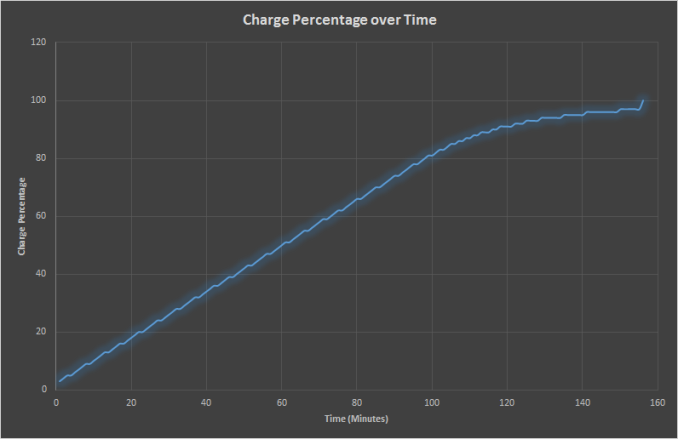
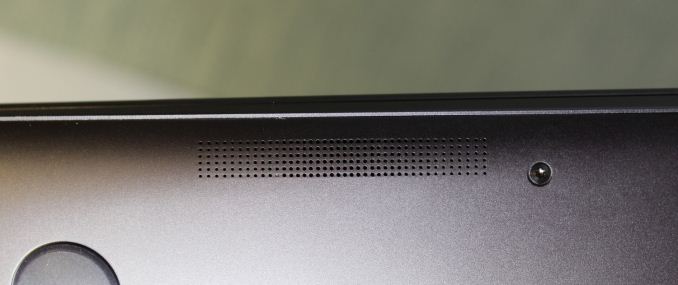
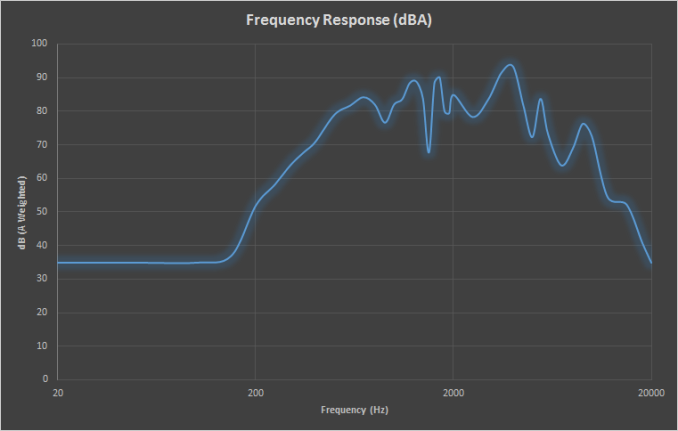








164 Comments
View All Comments
metayoshi - Wednesday, March 25, 2015 - link
I may be in the niche group right now, but I am pretty excited at what these 5W chips bring to the table. These chips are really where Windows on a tablet will stand out in my opinion. With much better performance than you get with the crappy Atom line of CPUs and with way better performance than anything ARM will provide, and then add in the millions of legacy programs that you can use on a full x86 Windows platform, and in my opinion, it's a winning combination. With products like Dell's Venue 11 Pro already upgraded to Core M, and with the upcoming Asus Transformer Book T300 Chi also coming in with Core M, and all for around $800, I find it worth the extra $300 to get better performance and get full blown Windows instead of being stuck in the limited Chromebook world. At this point, I'm waiting on reviews, and both of Anandtech's Core M reviews so far show me what I expected.Of course, I agree that this platform is not for everybody. A gamer should build their own gaming desktop, or invest in something like the Razer Blade if they want mobility, and a content consumer should just go Android Tablet, iPad, or Chromebook. But personally, I already have a gaming desktop at home that is overpowered for the task in my mind and would benefit from being mobile, but the task is incompatible with anything but Windows, so my smartphone or non-Windows tablet can't even run to program, and Atom is far too weak, so something with Core M is ideal.
In other words, if you don't want it, don't buy it. But to answer your top question, who asked for a 5 W notebook chip? I did.
eanazag - Monday, March 30, 2015 - link
I'm excited about these chips too because of battery life. For personal use I'd rather have some more gaming chops.I use a Surface Pro 1 for work and am happy with it except for battery life. The battery life isn't bad; I just know there is better out there and in consideration to my iPad I can't ditch the iPad.
r00fus - Wednesday, March 25, 2015 - link
Hyperbolic post is hyperbolic.Let us know how all your existing software runs on an ARM chip.
Go buy yourself a monster laptop if you want. I like having an option of a slim, sleek fanless form factor, even if the performance isn't top notch.
wetwareinterface - Wednesday, March 25, 2015 - link
because the MAINSTREAM of the notebook market won't even use the paltry power this offers. the MAINSTREAM user needs a web browser, a picture viewer, video playback software and at rare intervals the ability to run office. 8GB of ram means they won't need an upgrade for a long time.V900 - Thursday, March 26, 2015 - link
But after a couple of weeks the MAINSTREAM will start to get annoyed with the slowdowns, the heat and the fact that you can't have more than a few programs running at once, whitout the laptop throttling down constantly. MAINSTREAM is especially annoyed how everything comes to a crawl when they're doing the virus scans. Because 8GB RAM doesn't change the fact that the puny 5 watt ceiling means that it spends half the time below 1 GHZ and with one core turned off.MAINSTREAM quickly realizes that much of the time, their iPad does a quicker and better job at looking something up online, or replying to an email.
V900 - Thursday, March 26, 2015 - link
Hey now! Apple certainly didn't put this halfassed, asthmatic excuse of a CPU in the MacBook Air.It's the craptastic 12 inch MacBook that has to suffer the indignity of being powered by a CoreM.
(And while I love Apple products and got an i-everything myself, both Apple and Apple fanboys have finally jumped the shark with the 12 inch MacBook. And the Koolaid-swillers can't believe how innovative it is: "It only has ONE port! So brave and futuristic!"
akdj - Saturday, March 28, 2015 - link
It's also fabless, with PCIe storage that flat FLIES, an excellent iGPU that'll help that meager Core m processor that is essentially as fast as the quickest core2duos (mobile)! As well, an operating system that scales your UI properly and sure, a single port. It's 'portable'. Not meant to be connected.You can certianly (& already) buy the proper docks and/or adaptors necessary to utilize USB 3, HDMI or VGA, & power it simultaneously. The traditional bottleneck for the 'mainstream' has NEVER been the CPU. Rather it's memory, storage sub system, OS or a combination of all at the above...including GPU. While you're an Apple fan, you should know just how great these displays and their HiDPI scaling through OS X (& iOS) has gotten since the release of the 2012 models and 'new' iPad (3).
This IS the computer for the 'Apple fanboy Kool-Aid swillers' unlike you and I that obviously need a bit more horsepower, I/O or 'strength' from our laptops. Most, don't. They're doing the 'lifting' at work on a supplied work station. They're using their MacBook to edit family photos, videos, neither using Premier, AE, Smoke or even FCPx ...nor photoshop. They're using iPhoto and iMovie, NEITHER of which will be slowed down to the point of frustration as they're doing what they NEED it to. Surf the web, check email, Facebook and Twitter, watch a flick or listen to music, even ALL those processes, simultaneously running won't create any 'perceived slow down' by the end user of they're not in need of the processing power and amount of ports you somehow believe we all need.
I get it. And own a pair of 15" rMBPs and they're the best computers I've ever owned, and to think it started on a IIe and monochrome display! That said, we get it, you're disgusted but guess what? ASUS literally JUST released the same 'halfassed, asthmatic of an excuse of a CPU' in their latest Ultralight line. Bit less money, but lesser IGPU, lesser storage speeds, and severely lacking display OOB without calibration. It's got your ports, but again I ask, Why?
Why the ports? Why a quad core i7 Xeon with GPUs in SLI? When no one wants anything p,urged in to their laptop on the train, on the plane or on the go? No need to charge, it lasts ten hours --- but if u need it, buy the 13" rMBP. Same tech, all the IO you seem to need and not so anemic a CPU
As an Apple fan myself, it's sad to see another 'fan' so clueless and ignorant to what a portable, laptop design should and shouldnt be (like the crappy hinge on the ASUS)
And you get OS X, an operating system built and 'intended' for maximum end user enjoyment and Performance --- 'real or perceived', it's irrelevant.
It's always nice to leave work at home
Haravikk - Thursday, March 26, 2015 - link
Who asked for a 5W notebook chip? To me the answer is anyone concerned about battery life and/or size; having to put a fan in a notebook adds to its bulk, not to mention making noise, reducing room for batteries and, if the processor needs a fan, reducing that battery life even further.Granted the screens are really the most demanding component these days, especially high-densisty screens requiring stronger backlights, but hopefully this will go down too (and you can run at reduced brightness to get some extra time out of the battery). But yeah; battery life improvements require everything to get more efficient, and that includes the processor. It might not be a massive leap in performance (or an improvement at all, depending upon what you're doing with it), but the efficiency improvements are enormous.
ragenalien - Thursday, March 26, 2015 - link
Because it's easier for intel to improve the power to performance ratio than merely making the chips faster with the same power. They've been doing this since sandy-bridge and it doesn't seem like they'll change that any time soon.frodbonzi - Thursday, March 26, 2015 - link
Except this laptop is $699.... not $1300...And for that "extra" $200, you get a thin, shiny laptop capable of doing 99% of what the "normal" user will want...You want to play uber games... buy an Alienware 18!